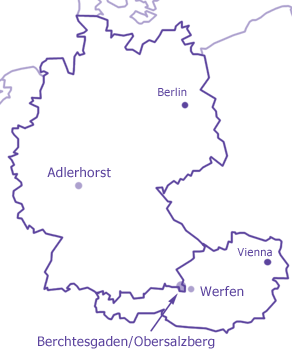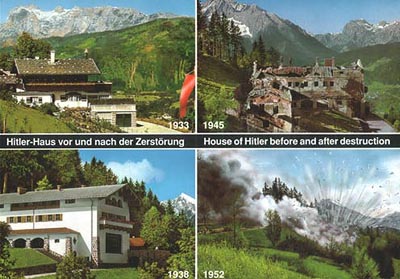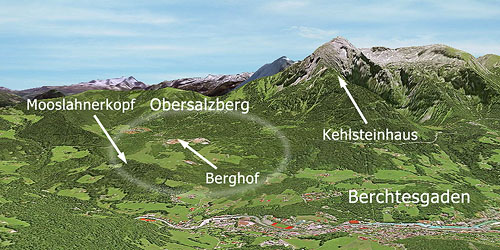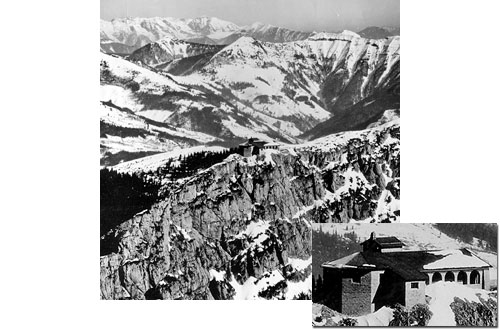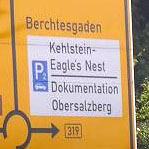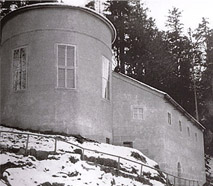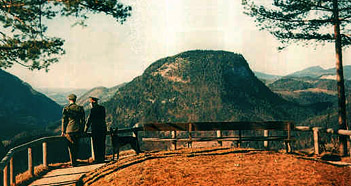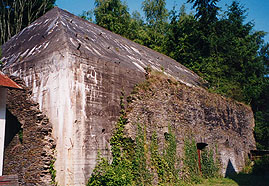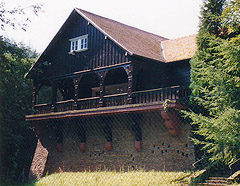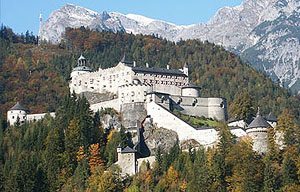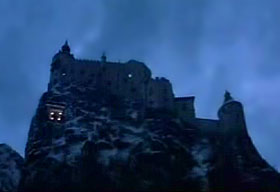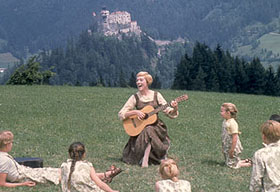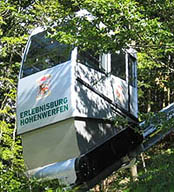|
The Eagle's Nest[ This text is also available in Swedish ] The famous name The Eagle's Nest can be attributed to several buildings/complexes: two in Berchtesgaden/Obersalzberg, one (or two?) in Hessen, and, as a bonus, one in Werfen, Austria. BerghofThis place has the strongest connection by far to Adolf Hitler. It was situated on Obersalzberg, a hill or part thereof (ein Berghang) near the town of Berchtesgaden in southeast Bavaria, not far from the Austrian border and places like Salzburg and Werfen. Hitler spent a lot of time at Berghof, met important people, held conferences, sent PMs etc.
Hitler found his way to this picturesque area in the early 20's. He rented Haus Wachenfeld several times until he, recently appointed Reichskanzler and with Mein Kampf doing great, was able to purchase it in 1933. It was then refurbished and expanded considerably, and got it's new name Berghof in 1936, Hof meaning "court" or "farm" (though in comparision with some other projects, it could very well be considered a modest mountain hut). Soon enough Obersalzberg was turned into a veritable Nazi ghetto, so to speak; the villagers were driven out, several in the party elite got their own houses there, and SS blocked the area from public use. In the end of the war the place was heavily bombed, and today there are hardly any visible remains of this building. KehlsteinhausBerchtesgaden and Obersalzberg are at the foot of the Alps, in particular the mountain Watzmann, at 2710 m the third highest in Germany. From the only slightly lower peak Hoher Göll (2522 m) the ridge Mannlgrat extends towards the mountain Kehlstein, and there (on 1834 m) Martin Bormann had a house built, which in April 1939 was given to Hitler on his 50th birthday. This house is called Das Kehlsteinhaus, and is as close as one can get to the popular image of The Eagle's Nest.
The project was very demanding and expensive. Just getting there required building a road winding it's way up the steep mountain side (the photo shows the other side). The final leg had to be solved by other means; no cable car, but something as bourgeoise as an elevator, inside the mountain. Visitors expecting a Schloss might be disappointed; the house isn't even a mansion. But the location is indeed nothing short of stupendous. Maybe it was a little too much for Hitler - perhaps the thin air got the better of him, or whatever the problem was, but he only came to the house a couple of times (Florian M. Beierl in his History of the Eagle's Nest (Plenk, 1998) sums it up to a total of 14), and he never slept there. Since the house had no military value nor "political" connections, it was saved from destruction. The Germans called the house Kehlsteinhaus, never The Eagle's Nest, Adlerhorst. The term was supposedly in use in English as early as 1938, having been introduced by the French diplomat André François Poncet. The earliest evidence I have found indeed quotes him: In the German press no hint of the Führer's astounding new retreat has been printed, but by last week many authentic details of the Adlerhorst (Eagle's Nest) had seeped through to the U. S. Perched on the pinnacle of Kehlstein Mountain, the house itself is comparatively small, consists mainly of one large circular room lined, except for a spot near the fireplace, with large windows. There are also a guard room, an electrically operated kitchen, and a balcony lookout. It is 6,000 feet above sea level, commands superb views of Bavaria and old Austria by night and day. The winds howl around it continually, white clouds float by. Time, March 13 1939 The roadsigns in the area direct tourists to "Eagle's Nest". The Nazis never used that name for Kehlsteinhaus.
Sometimes the Kehlsteinhaus is labeled "Hitler's tea-house". This might be a joke or a mistake; the "diplomat house", Das Diplomatenhaus, was abbreivated to Das D-Haus, which was easily turned into Das T-Haus = Tee-Haus = tea-house. Anyway, neither Hitler nor Bormann drank very much tea there. Mooslahnerkopf Teehaus
It could also be a confusion with an actual Teehaus in the area, built on the hill Mooslahnerkopf north of Berghof in 1937. This was another relatively small building with a relatively stunning view; nothing close to Kehlsteinhaus of course, but on the other hand it was far more frequented by Hitler. Adlerhorst - The Eagle's NestThough Berghof as well as Kehlsteinhaus have been called "The Eagle's Nest" incorrectly, Hitler indeed had an actual Adlerhorst. But it wasn't in Bavaria, wasn't nearly as visually stunning as Kehlsteinhaus, and additionaly it was top secret, unlike the others. This Führer HQ was located next to the town of Langenhain-Ziegenberg, near Bad Nauheim in the Taunus mountains, Hessen, and was called Adlerhorst - The Eagle's Nest.
This bunker complex was built in 1938-40 in the vicinity of castle Ziegenberg. It had an area of 3800 m². The seven bunkers above ground where camouflaged to look like common houses. Adlerhorst was built to be used as the Führer's HQ during the invasion of England (Operation Seelöwe), which never came to be. Instead, it was used during the Ardennes offensive ("The Battle of the Bulge") in December 1944 - January 1945; Hitler left it on the 15th of January 1945, for Berlin and Der Untergang. According to Geoff Walden of ThirdReichinRuins.com, however, the actual Adlerhorst was a country palace turned FHQ by Speer. This Hitler found "far too lavish" and had the more spartan Felsennest, "The Rock Nest" built nearby, which is what is actually described above. This switch seem to have escaped all other sources I've seen. Confusion to the bitter end. "The Eagle's Nest"? As for the confusing popular images of Hitler's mountain HQ, I think the name comes from Adlerhorst, the magnificient location from Kehlsteinhaus, and the importance from a real Führerhauptquartier like Berghof. That Poncet had even heard the name Adlerhorst could be a German screw-up, or maybe they had this idea, that people would confuse the top secret bunker with a Kehlsteinhaus of zero military importance. - In which case they succeeded very well indeed. Burg HohenwerfenI include this one due to it's silver screen fame.
"The Eagle Castle", Schloss Adler in the film Where Eagles Dare, is actually Burg Hohenwerfen. It's a genuine medieval castle, and it's located in the Austrian town of Werfen, some 50 km south of Salzburg. It's also located on a hill, as castles often are - not on a mountain top, though. It has no cable cars - they were filmed in Ebensee - though in 2006, a kind of train was installed.
This Festung was "given" to the Nazis after the Anschluss of 1938. They used it for civilian education, Gauschule. It had no military purpose.
A final remark: In this context, the eagle refers to the German eagle, the symbol of the country. Together with the swastika of the party, it formed the symbol of the Third Reich. Sources:
|


